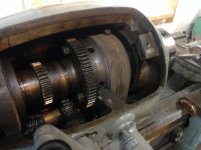Trboatworks
Diamond
- Joined
- Oct 23, 2010
- Location
- Maryland- USA
Any humor anyone can manage would be appreciated.
I don't have much as I crashed this nice little lathe I have and bent the spindle.
Lathe- that nice Hendey T&G I have.
What I did- Parting a 1.2" gummy steel rod and had the work climb up over the HSS blade and stall the lathe.
How I know it's bent- I had measured at the base of the taper on nose as I was setting up lathe and found 0 detectable runout using a Interrapid .0001 indicator.
Now I have ~.001 runout at same spot with is duplicated on same axis out on the various surfaces on the nose.
I plowed through the old posts here and found consensus that it is very unlikely that a seemingly minor crash bent the spindle.
"In 40 years of machine repair, I never saw a bent spindle even in some crashes which broke the bed right it two" etc.
On remediation- I found press work by someone who has a gift for the work seems like the way to go.
I also found the comment by Forrest that high grade lathes have the spindle ground in place.
I also had heard this before in regards to Hardinge lathes.
The only thing I can think of is sending out the spindle for grinding if it is possible to re-establish the various surfaces on the nose to the degree of accuracy require through this route..
The lathe has a 1-1/2" bore, D1-4 nose with M5 taper inside.
If there is a PM firing squad going to be assembled for such trespasses- tell me when to show up and I will bring the donuts.
I suppose I prefer hood on..
Thanks all
I don't have much as I crashed this nice little lathe I have and bent the spindle.
Lathe- that nice Hendey T&G I have.
What I did- Parting a 1.2" gummy steel rod and had the work climb up over the HSS blade and stall the lathe.
How I know it's bent- I had measured at the base of the taper on nose as I was setting up lathe and found 0 detectable runout using a Interrapid .0001 indicator.
Now I have ~.001 runout at same spot with is duplicated on same axis out on the various surfaces on the nose.
I plowed through the old posts here and found consensus that it is very unlikely that a seemingly minor crash bent the spindle.
"In 40 years of machine repair, I never saw a bent spindle even in some crashes which broke the bed right it two" etc.
On remediation- I found press work by someone who has a gift for the work seems like the way to go.
I also found the comment by Forrest that high grade lathes have the spindle ground in place.
I also had heard this before in regards to Hardinge lathes.
The only thing I can think of is sending out the spindle for grinding if it is possible to re-establish the various surfaces on the nose to the degree of accuracy require through this route..
The lathe has a 1-1/2" bore, D1-4 nose with M5 taper inside.
If there is a PM firing squad going to be assembled for such trespasses- tell me when to show up and I will bring the donuts.
I suppose I prefer hood on..
Thanks all



